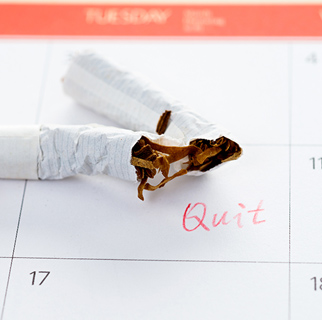Quit-Smoking Tools: Help for Kicking Your Habit

If you're a smoker and you need some more reasons to quit, look at what the U.S. Surgeon General has to say: If you stop now, you'll have a better quality of life and more years to live it.
As you likely already know, quitting smoking isn't easy. But millions of other people have done it. And you can, too. Quit-smoking aids, such as those listed here, can increase your chance of success:
-
Quit lines. When you call a quit line, you can talk with someone who's trained to help people quit smoking. It's free. And you can call almost any time. Find a quit line by calling the American Cancer Society.
-
Nicotine patches. They give you a measured dose of nicotine through your skin to fight cravings. And you can buy patches without a prescription. Several types and strengths are available. The 1 you choose depends on your body size. And it also depends on how much you smoked. Try to slowly decrease your dose. These patches have been known to cause trouble sleeping. If this happens to you, remove the patch before going to bed. Replace it when you wake up.
-
Nicotine gum. This fast-acting form of nicotine replacement doesn't need a prescription. And it comes in 2 strengths: 2 mg and 4 mg. Chew the gum slowly until it tastes peppery. Then place the gum against your cheek. Switch between chewing it and placing it next to your cheek. Do this for about 20 to 30 minutes. But don't eat or drink anything when using the gum. This reduces nicotine absorption. Scheduling your doses throughout the day may work better to calm your cravings.
-
Nicotine nasal spray. A prescription nasal spray sends nicotine quickly to the bloodstream. So, it eases withdrawal symptoms right away. The spray offers a sense of control over your cravings. Most smokers using it report great results. But it can cause sneezing and watery eyes because it tastes peppery. The FDA advises using it for up to 6 months only.
-
Nicotine inhalers. Using this prescription device is like smoking a cigarette. When you puff on the inhaler, a cartridge inside the plastic tube gives off nicotine. But the medicine doesn't go into your lungs. It's delivered to your mouth for quick absorption.
-
Nicotine lozenges. These over-the-counter lozenges also are available in 2-mg and 4-mg strengths. You decide which dose to take. This is based on when you often had your first cigarette of the day. You'll absorb less nicotine if you eat or drink while using a lozenge.
-
Bupropion. This non-nicotine prescription medicine affects chemicals that are responsible for cravings. So, it reduces withdrawal symptoms. It has the active ingredient bupropion. This is used as an antidepressant. You can use it alone or with nicotine-replacement therapy.
-
Varenicline. This oral prescription medicine reduces nicotine withdrawal symptoms. It also decreases the pleasure you get from smoking. Side effects can include changes in mood or behavior. It's important to use this medicine under medical supervision.
Quit-smoking aids can help you have a smoke-free future. But it's also smart to develop a plan to change your personal habits. And to set up a network of emotional support. Turn to family and friends, and your healthcare provider. They can give you valuable information on quitting. Also go to www.smokefree.gov for support and tips.
Online Medical Reviewer:
Eric Perez MD
Online Medical Reviewer:
L Renee Watson MSN RN
Online Medical Reviewer:
Marianne Fraser MSN RN
Date Last Reviewed:
4/1/2022
© 2000-2025 The StayWell Company, LLC. All rights reserved. This information is not intended as a substitute for professional medical care. Always follow your healthcare professional's instructions.